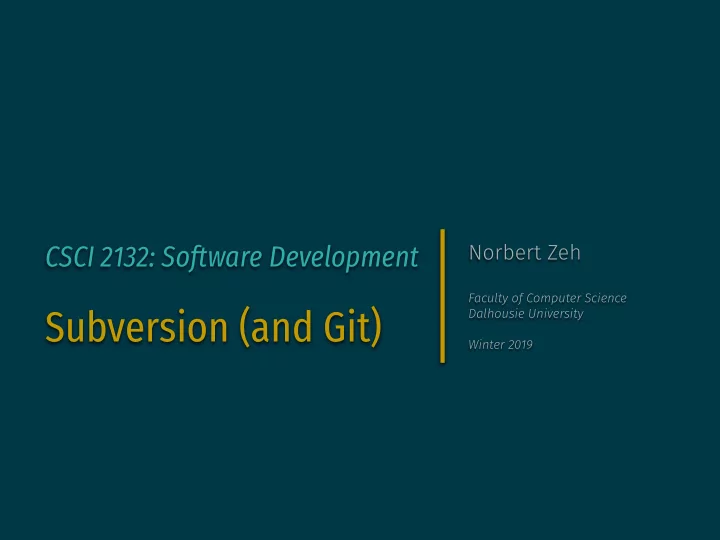

CSCI 2132: Software Development Norbert Zeh Faculty of Computer Science Subversion (and Git) Dalhousie University Winter 2019
Version Control Systems A version control system allows us to • Record the history of changes to the source code of some software we are writing (and many more) • Maintain multiple versions of the (software) product • Coordinate the work by multiple team members via • Multiple branches • Support for merging from different branches Two main types of VCS: • Centralized: one central repository (RCS, SCCS, VCS, Subversion, ...) • Distributed: multiple distributed repositories (Git, Darcs, Mercurial, ...)
Version Control Using Subversion (SVN) Working copy 1 Working copy 2 A simplified view: • Backups: Create backups in Files, directories Files, directories a repository • History: “Time machine”, SVN repository labelled versions • Collaborative, central repository: Different users can contribute Files, directories Files, directories and merge changes Working copy 3 Working copy 4
SVN Checkout • Create an initial working copy: $ svn checkout or $ svn co SVN repository
SVN Checkout • Create an initial working copy: $ svn checkout or $ svn co Working copy SVN repository Files, directories
SVN Add • Creating files in the working copy does not add them to subversion! • svn add adds them to SVN’s list of files to manage • The SVN repository does not know about the added file yet! $ svn add newfile.txt Working copy SVN repository + newfile.txt
SVN Commit • svn commit saves local changes to the repository. • Local working copy is kept. • Local working copy can then be deleted without affecting the repository. • svn commit requires a log message that documents the changes that were made in this commit. $ svn commit - m”Added newfile.txt” Working copy SVN repository newfile.txt
SVN Commit • svn commit saves local changes to the repository. • Local working copy is kept. • Local working copy can then be deleted without affecting the repository. • svn commit requires a log message that documents the changes that were made in this commit. $ svn commit - m”Added newfile.txt” $ cd �./ ; rm - r WorkingCopy SVN repository
SVN Update • SVN does not allow you to commit changes unless your local copy has an up-to-date view of the repository, including changes others may have committed from their working copies. • svn update updates your local copy according to the current state of the repository. • This may create conflicts that you may have to resolve before committing your changes. • The chance for conflicts increases the longer you work without running svn update . ⟹ Run svn update periodically. Working copy 1 Working copy 2 SVN repository newfile.txt
SVN Update • SVN does not allow you to commit changes unless your local copy has an up-to-date view of the repository, including changes others may have committed from their working copies. • svn update updates your local copy according to the current state of the repository. • This may create conflicts that you may have to resolve before committing your changes. • The chance for conflicts increases the longer you work without running svn update . ⟹ Run svn update periodically. Working copy 1 Working copy 2 SVN repository newfile.txt newfile.txt
(Re)moving files • Moving a file will not move it in the repository. • Removing a file will not remove it from the repository. • SVN complains about the missing file the next time we try to run svn commit . • svn rm removes the file from the repository. • svn mv renames or moves the file within SVN’s file tree. • Changes will take effect when running svn commit next.
SVN Troubleshooting • Do not interrupt an SVN operation (unless it’s hung, takes very long). (This may leave SVN in a corrupt state.) • Helpful commands: svn info , svn status - v , svn log - v • A working copy contains a hidden .svn directory, which stores administrative information about the working copy. • Resolve problems by moving or removing a working copy and checking out a new copy. • If you allow SVN to save your password, you can remove it with rm ~/.subversion/auth/svn.simple �/+ .
SVN and Git • Many version control systems (SCCS → RCS → CVS → Subversion, Git, Mercurial, Darcs, …). • SVN and Git are the most popular representatives of two competing philosophies: • SVN (RCS, CVS, …): One centralized repository • Git (Mercurial, Darcs, …): Fully distributed, no centralized repository • More on Git later. • Git can be used in a subversion-like manner: • svn co ≈ git clone • svn add ≈ git add • svn commit ≈ git commit + git push • svn update ≈ git pull
Recommend
More recommend